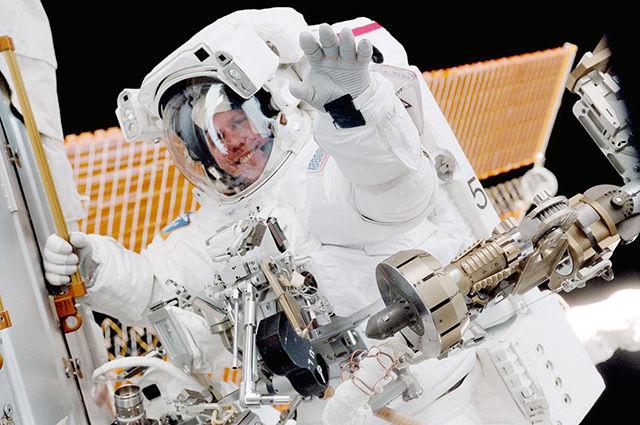Tom Jones dreamt of being an astronaut since he was 5-years-old. His interest was sparked after he recieved a $0.25 children’s book about space—a gift from his grandmother. Jones’ book was filled with hand-drawn pictures because, at that time, the high-definition pictures of the cosmos that we’re used to, didn’t exist.
Four space trips and 55 years later, Jones spoke to a crowd of roughly 70 in Park Shops Monday afternoon. He showed off his space selfies with planet Earth casually floating in the background.
Durning his visit, Jones presented Mia De Los Reyes, a senior studying physics and math , with the Astronaut Scholarship Foundation award. Her accomplishments include working at CERN, a European nuclear research firm, publishing an article on the evolution of galaxies and mentoring the Serious About Math & Science Club at Enloe High School.
During his talk, Jones said that not just anybody can work for NASA. He told the crowd that one of his colleagues had to apply 14 times before finally being offered a position. Fortunately, Jones’ third try was ticket in. Out of 3,000 applicants only 23 were chosen and he was one of them.He was selected in January of 1990.
“First time somebody rejects your application, you don’t just walk away from your dream career,” Jones said. “You just keep trying to get better in your qualifications. You get to be stubborn, determined and you make up your mind. You’re not going to give up until they physically kick you out the door.”
As a NASA astronaut, Jones has flown four space shuttle flights: STS-59, STS-68, STS-80 and STS-98. STS-80 currently holds the world record of being the longest shuttle mission ever flown, lasting more than 17 days. Jones compared the takeoff vibrations to being in a pickup truck going 50 miles per hour.
Accoring to Jones NASA will be ready to launch, within th enext decade, a new spacecraft called the Orion along with a new booster called the Space Launch System.
“The Orion and that new booster can go out into deep space,” Jones said. “In the 2020s we would like to see astronaut crews head back to the moon to check out the resources that are there. There’s ice on the poles of the moon that can be used to make water. You can drink the water, you can breathe the oxygen from the water, you can make oxygen and hydrogen propellants from the water itself.”
Jones predicts a future with heavier emphasis on mining these types of resources and on learning how to deal with spontaneous asteroids.
Asteroids, like the moon, also have rocks with valuable material. Their water resources, metals and organic chemicals will breathe life into a new space-economy for the future, Jones explained.
“We are now a space-faring species,” Jones said. “This is lucky for us because the asteroids come visiting our home planet frequently unannounced. And we will be struck again, so we need to be out in space learning how to nudge rogue asteroids off course in the future.”
Jones referenced the Chelyabinsk meteor from 2013 that hospitalized 1,000 Russians upon impact. He also told the crowd that he didn’t want people to meet the same fate as the dinosaurs.
“Of course, the people who will be doing these jobs aren’t even in NASA right now,” Jones said. “They are you. The students sitting in this audience and students in high school today and students in middle school today. They will be the ones to accomplish this.”
Jones explained that he is hopeful for the future of space exploration thanks to the students sitting in the audience listening to him.
“I’d like to see us go farther,” he said. “Beyond the space station and into deep space.”








